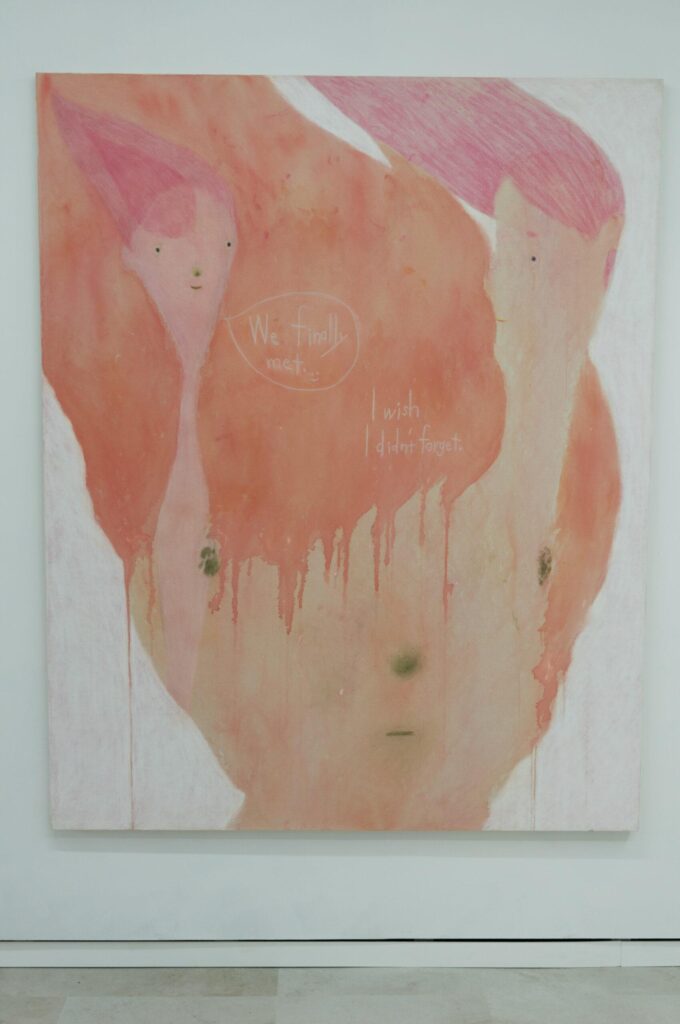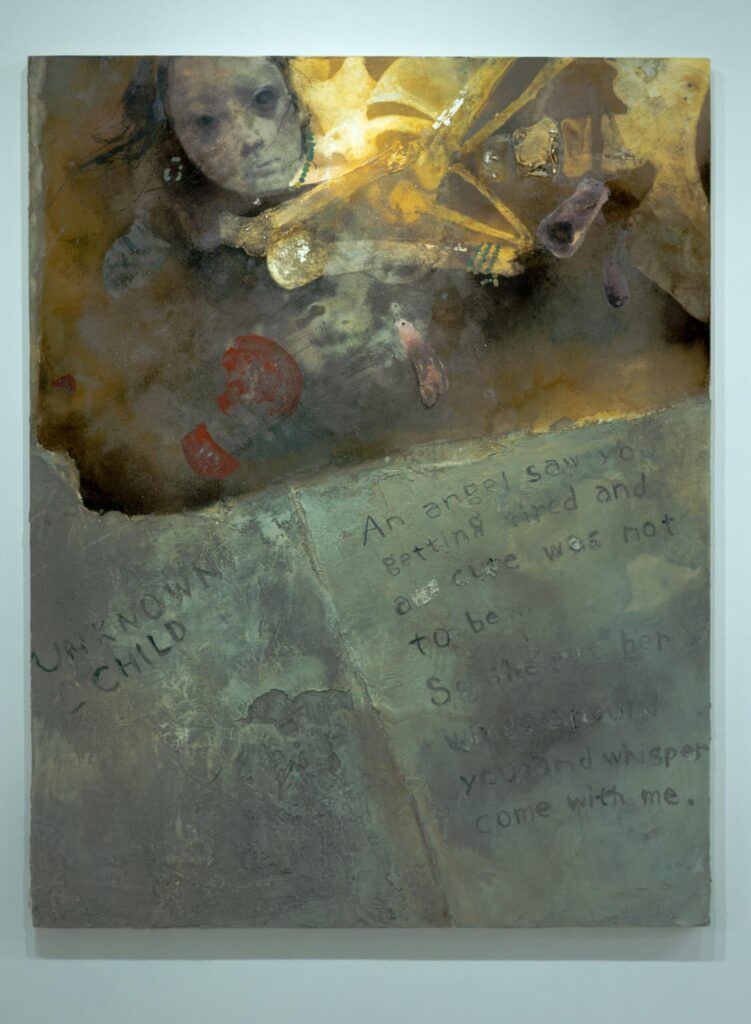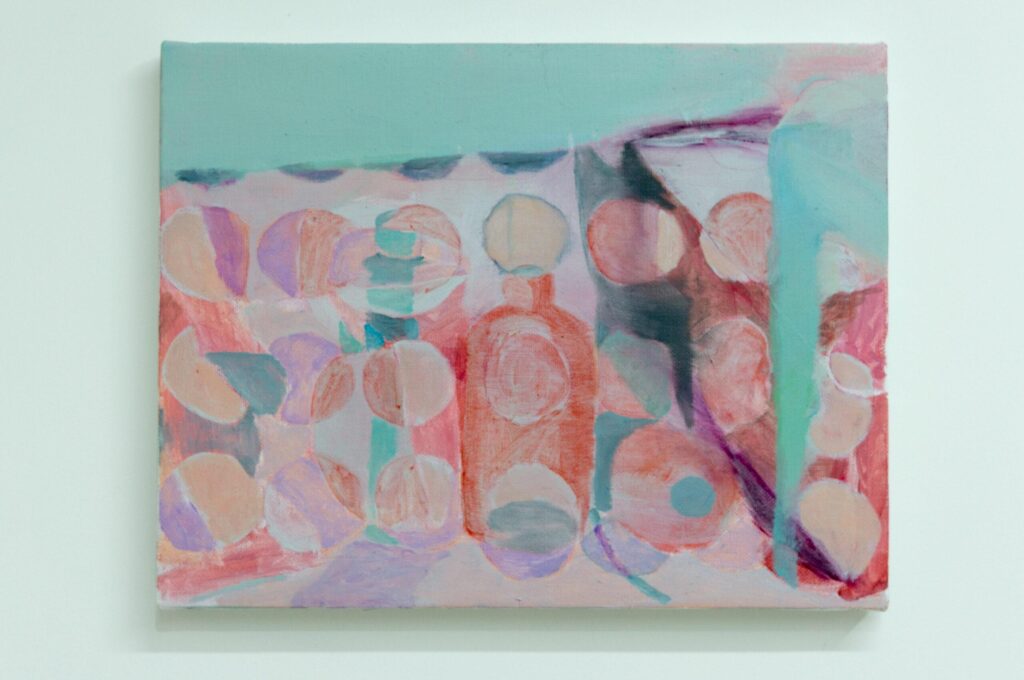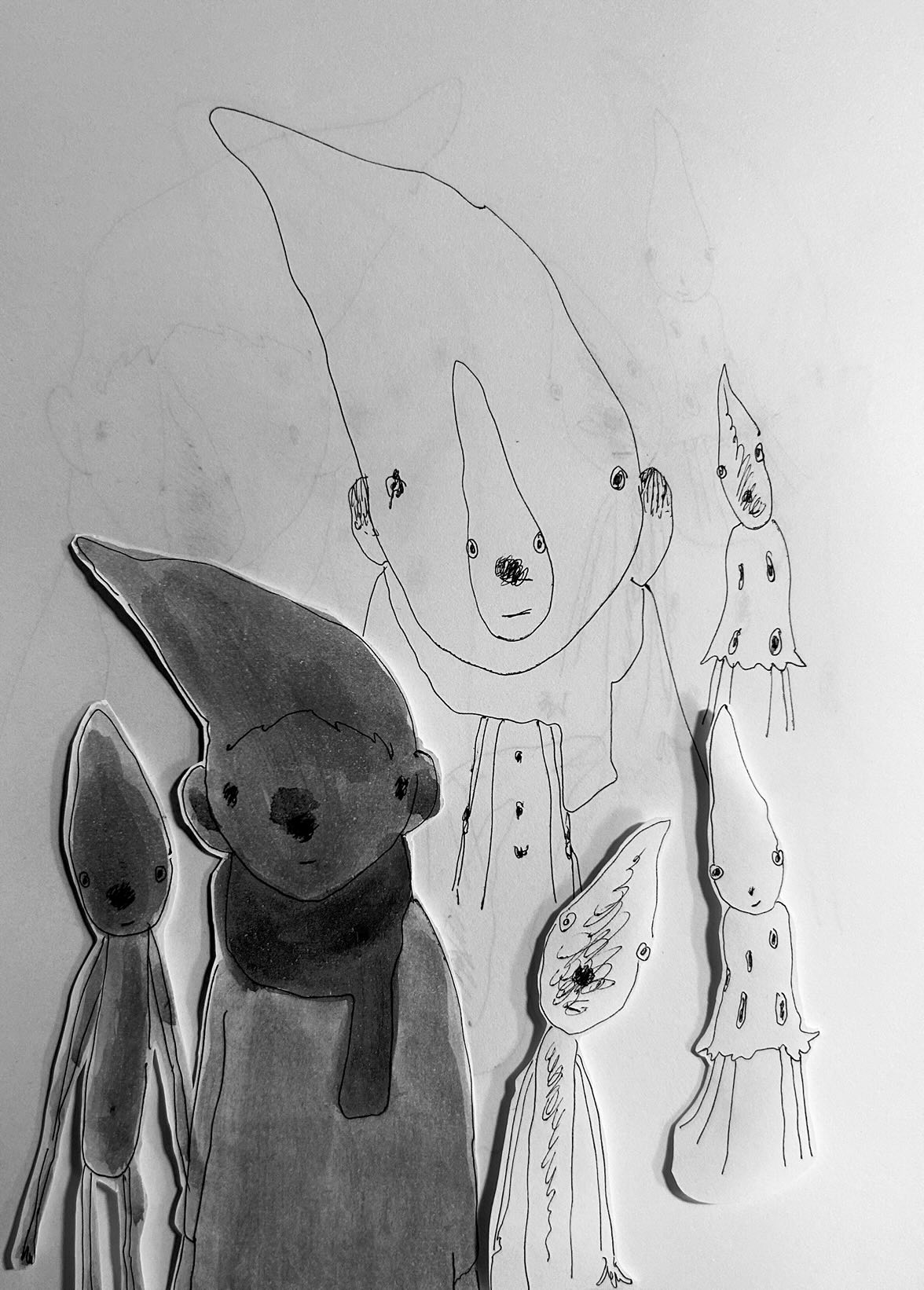Opening Statement
aaploit is pleased to present “Dust in the Teeth of the Comb” (Kushi no Me no Hokori), a three-person exhibition featuring Ishiodori Michi, Ishiguro Hikaru, and Shikura Toka, running from March 14 through March 30, 2025. This collaborative exhibition emerged from extensive dialogue between the three artists, with aaploit participating in both the conceptual development and curatorial framework. The exhibition represents a compelling investigation into the overlooked minutiae of daily existence, transforming seemingly insignificant encounters into profound artistic statements that challenge conventional perceptions of contemporary reality.
Born from the artists’ shared recognition that the era of grand narratives has concluded, this exhibition embodies what art critic Matsui Midori identifies as the essential survival strategy for uncertain times: the creation of individual, unique “idioms” within dominant culture that enable new ways of perceiving and operating within the world.¹ Rather than merely documenting or representing the everyday, these three artists demonstrate how contemporary art continuously updates its gaze toward daily life, reconstructing reality to reveal previously hidden meanings and connections.
Exhibition Overview/Concept
“Dust in the Teeth of the Comb” operates on the premise that the most profound artistic discoveries often reside in the spaces between attention—those microscopic territories where awareness falters and the unconscious accumulates its sediment. The exhibition’s title itself suggests this delicate archaeology of the overlooked: dust caught in the fine spaces of a comb becomes metaphor for the accumulated detritus of experience, the traces of living that remain invisible yet fundamentally constitute our material reality.
The curatorial framework emerges from extensive conversations between the artists, revealing their shared commitment to exploring the uncomfortable zones of daily existence—those moments of cognitive dissonance where familiar objects and experiences reveal their underlying strangeness. This approach aligns with what Matsui Midori describes as the creation of personal “idioms” within dominant cultural frameworks, enabling individuals to develop new methodologies for perceiving and navigating contemporary existence.¹
It seems the exhibition’s conceptual framework is built upon contemporary art’s relationship to the everyday extends far beyond simple documentation or representation. Instead, these artists engage in active reconstruction of reality, employing materials, techniques, and conceptual frameworks that transform quotidian experience into sites of philosophical inquiry. Their work demonstrates how the seemingly personal and subjective can reveal universal structures of perception, memory, and material engagement.
Central to the exhibition’s thesis is the recognition that modern life produces specific forms of alienation and disconnection that require new artistic strategies to address. The three artists’ approaches—while individually distinct—collectively propose that attention to the marginal, the overlooked, and the in-between can generate profound insights into contemporary existence and consciousness.
Artistic Practice/Individual Approaches
Ishiodori Michi employs paper clay (kami nendo) as her primary medium, creating flat works that exploit the material’s inherent contradictions between three-dimensional potential and two-dimensional presentation. Her practice involves a deliberate embrace of primitive expression that simultaneously functions as sophisticated ontological inquiry. Through paper clay’s malleable properties applied to flat surfaces, Ishiodori creates works that exist in constant tension between their sculptural origins and pictorial presence. The choice of this particular medium—affordable, accessible, yet requiring considerable skill to manipulate effectively—reflects her broader interest in undermining hierarchies between “serious” and “amateur” artistic production.
Ishiodori’s work process involves extended periods of handling and reworking the clay on flat surfaces, allowing the material’s own properties to guide formal decisions while maintaining precise control over conceptual development. This approach generates works that appear to emerge from unconscious processes while remaining intellectually rigorous in their engagement with questions of authenticity, originality, and artistic value. Her flat works often present inverted relationships between reality and fiction, using the tactile immediacy of clay pressed into two-dimensional formats to explore how material experience shapes cognitive understanding.

Ishiguro Hikaru develops his practice through sustained engagement with Marcel Duchamp’s concept of “inframince” (the infra-thin), extracting from it a unique investigation into interfacial zones where matter and consciousness intersect. Ishiguro’s work explores the subtle resonances that emerge between material substances and the perceiving mind, focusing particularly on those liminal moments where objective reality becomes subjective experience.
His artistic methodology involves creating situations where viewers become acutely aware of their own perceptual processes, often through subtle manipulations of familiar materials or spatial arrangements. Drawing from traditional Japanese painting techniques while engaging contemporary conceptual frameworks, Ishiguro creates works that function as meditation devices, slowing down the viewer’s engagement to reveal normally invisible layers of experience.
The artist’s exploration of the character “person” (hito) as both linguistic sign and phenomenological reality generates works that operate as dialogues with the self, creating traces of internal conflicts between introspection and resistance. This dual approach—simultaneously investigating material interfaces and psychological territories—positions his work as investigation into the nature of contemporary subjectivity itself.

Shikura Toka employs systematic deconstruction and reconstruction of remembered landscapes and motifs, creating what she terms “displacements” (zureshi) that function as critiques of visual pleasure and cognitive certainty. Her process involves deliberately fragmenting coherent images or experiences, then reassembling them according to alternative logics that reveal the constructed nature of perception itself.
Working primarily through painting and mixed media installation, Toka creates environments where familiar elements become strange through subtle shifts in scale, color relationships, or spatial positioning. Her “erasures” (kaki keshi) are not simple deletions but active interventions that expose the mechanisms through which visual information becomes meaningful. This approach transforms the act of looking into a conscious process, making viewers aware of their own interpretive activity.
Toka’s work emerges from extensive research into memory formation and visual cognition, translating theoretical insights into immediate aesthetic experiences. Her installations often incorporate elements that change based on viewing position or temporal duration, creating situations where the work’s meaning remains unfixed and dependent on viewer engagement.

Works and Spatial Experience
The exhibition’s spatial arrangement reflects careful consideration of how individual works interact to create collective meaning while maintaining the integrity of each artist’s distinct approach. Works are positioned to create sightlines and relationships that emerge gradually as viewers move through the space, allowing for both focused individual encounters and broader curatorial dialogue.
Ishiodori’s paper clay works are positioned to take advantage of natural lighting conditions, revealing how their surfaces change throughout the day. The flat works’ intimate scale encourages close examination, creating encounters that blur the boundaries between painting and sculpture. Her pieces often incorporate found objects or everyday materials pressed into the clay surface, creating assemblages that hover between recognition and puzzlement.
Ishiguro’s works utilize subtle interventions that viewers might initially overlook. This strategic placement reflects his interest in “inframince” phenomena—those barely perceptible shifts that nonetheless produce significant changes in awareness. His pieces often incorporate elements that respond to environmental conditions such as humidity, temperature, or air circulation, making the atmosphere itself a component of the work.
Toka’s paintings and installations command central viewing areas while extending into peripheral spaces through strategic placement of smaller elements. Her large-scale works create immersive environments that surround viewers, while smaller pieces function as focusing devices that direct attention to specific aspects of the larger installation. The interplay between different scales of work creates a rhythm that guides viewer movement while allowing for multiple entry points into her conceptual framework.
The collective spatial experience emphasizes duration and attention, encouraging viewers to spend extended time with individual works while remaining aware of the larger curatorial conversation. The exhibition design creates moments of visual rest alongside areas of intense concentration, reflecting the artists’ shared interest in the subtle modulations of everyday awareness.
Critical Context
“Dust in the Teeth of the Comb” participates in ongoing international discourse around what might be termed “post-conceptual materialism”—artistic practices that combine conceptual rigor with renewed attention to material properties and sensory experience. This approach reflects broader cultural shifts away from purely theoretical or digital engagement toward practices that acknowledge the irreducible reality of physical existence.
The exhibition’s exploration of everyday alienation connects to broader developments in contemporary art that address the psychological and social effects of accelerated technological change. While avoiding explicit political commentary, the works collectively suggest that artistic attention to marginal experiences can function as resistance to dominant cultural narratives that prioritize efficiency, productivity, and measurable outcomes over subjective quality and experiential depth.
Within the context of contemporary Japanese art, the exhibition represents a generation of artists who inherited both the international outlook of postwar Japanese art and the material consciousness of traditional Japanese aesthetic practices. Their work demonstrates how contemporary artists can engage global artistic discourse while maintaining connection to specifically Japanese approaches to materiality, temporality, and aesthetic experience.
The exhibition’s emphasis on collaborative development and dialogue-based creation reflects broader shifts in artistic practice toward more collective and process-oriented approaches. Rather than presenting individual artistic visions in isolation, “Dust in the Teeth of the Comb” models how artistic meaning can emerge through sustained conversation and mutual influence.
The accompanying dialogue project with contemporary art researcher Risa Yoshida positions the exhibition within broader critical discourse while providing additional interpretive frameworks for understanding the artists’ approaches. This integration of critical and creative practice reflects contemporary art’s increasing engagement with theoretical investigation as component of artistic production itself.
Artist Information
Ishiodori Michi graduated from Joshibi University of Art and Design’s Visual Design program in 2024, quickly establishing herself within Tokyo’s alternative art scene through participation in significant group exhibitions. Her involvement in exhibitions at venues such as Shinjuku Ophthalmology Gallery, powderoom, and Room_412 demonstrates her engagement with experimental approaches to contemporary art presentation and her interest in collaborative artistic communities.
Ishiodori’s rapid emergence following graduation reflects her development of a distinctive artistic voice that combines accessible materials with sophisticated conceptual frameworks. Her participation in exhibitions with provocative titles such as “How to Open New Doors,” “DAYTIME,” and “Still a Bucket Even if the Bottom Falls Out” suggests her interest in work that challenges conventional expectations while maintaining accessibility to diverse audiences.
Ishiguro Hikaru graduated from Tohoku University of Art and Design’s Japanese Painting program in 2024 and is currently pursuing graduate studies in the Painting Research Area. His solo exhibition “witch craft” at haco-art brewing gallery demonstrates his commitment to developing individual artistic vision while engaging collaborative opportunities through group exhibitions.
Ishiguro’s international exhibition experience, including shows in Seoul, positions him within global contemporary art discourse while his foundation in traditional Japanese painting techniques provides distinctive material and conceptual resources. His recognition through the 2023 Tohoku University of Art and Design Art Department Award indicates institutional acknowledgment of his innovative approach to traditional media.
His ongoing graduate studies suggest continued development of theoretical frameworks that support his practical investigations, positioning him as an artist-researcher whose work contributes to broader understanding of contemporary painting’s possibilities.
Shikura Toka graduated from Tama Art University’s Oil Painting program in 2024 and is currently pursuing graduate study in the Oil Painting Research Area. Her rapid establishment within Tokyo’s contemporary art scene through exhibitions at venues such as Room_412 and her inclusion in shows with titles like “Slept Well with the Lights On” and “Hair Clip” demonstrates her engagement with experimental approaches to painting and installation.
Toka’s academic background in oil painting combined with her conceptual approach to image-making reflects broader developments in contemporary painting that combine traditional technical skills with theoretical investigation. Her participation in exhibitions that emphasize process, collaboration, and non-traditional presentation formats suggests her interest in expanding painting’s possibilities beyond conventional gallery contexts.
Her ongoing graduate studies indicate continued development of research methodologies that support her artistic practice, positioning her as part of a generation of artists who integrate critical theory with material investigation.
References
- Matsui, Midori. The Age of Micro-Pop: The Door to Summer. Tokyo: PARCO Publishing, 2007. pp. 30-32.
Exhibition Details
“Dust in the Teeth of the Comb” (Kushi no Me no Hokori)
Artists: Ishiodori Michi, Ishiguro Hikaru, Shikura Toka
Dates: March 14 – March 30, 2025
Hours: Friday, Saturday, Sunday 13:00-18:00
*Private appointments available on weekdays
Venue: aaploit
TMK Building 2F, 1-21-17 Sekiguchi, Bunkyo-ku, Tokyo
Inquiries: info@aaploit.com
